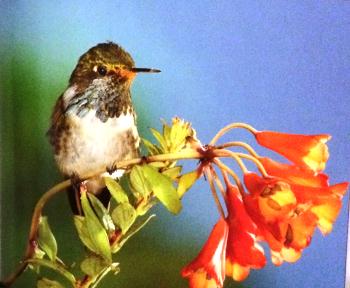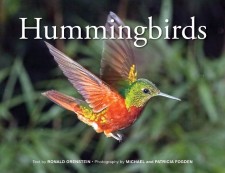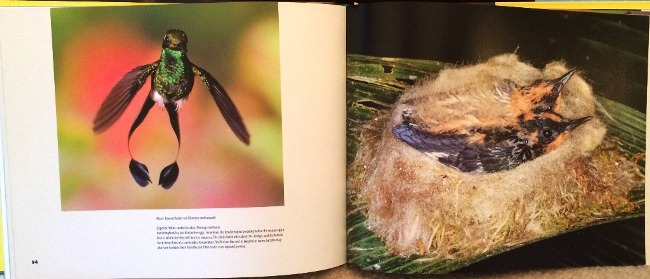Reviewed by Grant McCreary on October 16th, 2014.
To get an idea of how extraordinary hummingbirds are, you need look no further than the names we’ve given them: emerald, sapphire, ruby, coquette, woodnymph, fairy, comet, sunangel, brilliant. There is even a hummingbird named Shining Sunbeam. That sounds a little crazy and more than a little hippy-ish. Until you see it. Then, the name is a perfect fit. These amazing birds are unique, not just for birds, but among all vertebrates. This uniqueness is celebrated in Hummingbirds.
Hummingbirds reveals the remarkable nature of these birds in two ways – a short natural history of the family by Orenstein and photographs by the Fogdens. There are 200 photos, most contained in the “portfolio” that makes up over two-thirds of the book. I know you’re going to go right that section first, don’t bother denying it. (Not that there’s anything wrong with that!) But after you’re done ogling, make sure you go back and actually read the book. Orenstein succinctly details all the ways in which hummingbirds shine (literally and figuratively).
All the basic natural history information is included – how hummingbirds fly, what they eat, breeding, etc. But Orenstein takes a slightly different approach than is usual. As he writes in the forward, “Rather than turn out yet another general natural history of the hummingbird family, I have made the theme of this book the things that make these extraordinary creatures unique among birds.” He also focuses on recent discoveries and research. I like this approach, it makes for a very interesting read. Unless you are already well-versed in the latest hummingbird studies, you’ll learn a great deal here. For example, the author describes how these birds catch insects in mid-air. Even though I’ve seen some amazing high-speed footage of this, I still learned a great deal about the process here.

This Volcano Hummingbird looks much better in the actual book.
There are so many spectacular images here that it’s impossible to pick a favorite. The Volcano Hummingbird on page 73 (and left here), for example, is the perfectly idealized shot of a hummingbird perched on a flower, while page 187 shows a Tawny-bellied Hermit flying in front of a flower so clearly that you can see the intricate feather structure. And then there are the shots of a Rufous-tailed Hummingbird next to a bunch of flowers on which an Eyelash Viper is perched in ambush. The first photo shows the bird coming in to investigate. The next has the snake lunging out, fangs flared, with the hummer making a narrow escape. I don’t know how long the Fogdens had to wait for that moment, but it was worth it. But, for me, I don’t know if it can get much better than pages 94-95 with an amazing Booted Raquet-tail on one page and on the other a pair of adorable White-necked Jacobin chicks in their nest (see below).
The hummingbirds shown here are almost exclusively Central American, western South American (Colombia, Ecuador, and Peru), or widespread birds. There are only three that I would consider North American – Ruby-throated, Rufous, and Costa’s (plus the widespread Magnificent). But there are numerous other books that focus on North American hummingbirds. However, I was disappointed that there is only one Caribbean species (Red-billed Streamertail). Still, while the geographic diversity is less than ideal, the emphasis is on regions that are likely to host the most visiting birders.
There is another deficiency in diversity that is much more of an issue. Out of the 200 photographs in Hummingbirds, only 70 species are represented. Now, this book isn’t intended to be a comprehensive photographic guide (instead, see Hummingbirds: A Life-Size Guide to Every Species [which, despite the title, still isn’t complete]), but there are too many repeats for me. Granted, this is sometimes put to good effect, such as the comparison of Fiery-throated Hummingbirds from different angles, demonstrating the directionality of their iridescence. And some, like most of the Booted Racket-tail shots, are different and spectacular enough to warrant inclusion, but many others are so similar as to be redundant. Worst of all, in two cases the exact same photo is included twice, once in each portion of the book.
This is doubly disappointing because there are several hummingbirds that I would love to see here that are not included. The largest and smallest hummingbirds (Giant and Bee, respectively) are MIA and there are none of the sprightly coquettes. And, almost unthinkably, there is no Marvelous Spatuletail. Though to be fair, I have to weigh that against some lesser-known species that are included, such as the endangered Juan Fernandez Firecrown.
Each photo is captioned with the species’ common and scientific names, and many have an extended caption that tells some interesting fact about what is being depicted. I was very disappointed that the date and, especially, location the photo was taken is not included. Such information can be very instructive. Even worse is that, unless the photo has an extended caption, the bird’s sex isn’t noted.
If it seems like I’m coming down hard on Hummingbirds, it’s not because these issues are so egregious as to warrant avoiding it. Rather, it’s because I’m disappointed; this book is SO CLOSE to being the perfect general-audience hummingbird book for birders and non-birders alike. The text is both interesting and informative, and should be appreciated by anyone who’s interested in these birds. The photos are true works of art; of course everyone will enjoy them. But the hummingbirds are one of the largest families of birds in the world, and birders will likely be disappointed with the relatively small number of them presented here.
Recommendation
There are many, many hummingbird books. But Hummingbirds stands out as a book that celebrates and explains, in both words and images, how wonderfully unique these birds are. I wish that its extensive portfolio had more diversity, but this is still the most impressive collection of hummingbird photographs that I’ve ever seen. Whether you want to learn more about these birds, see some insanely good pictures, or both, this is your book.
Disclosure: I get a small commission for purchases made through links in this post.
Buy from NHBS
(based in the U.K.)
Disclosure: The item reviewed here was a complementary review copy provided by the publisher. But the opinion expressed here is my own, it has not been influenced in any way.







Comment